The NASA Electronic Parts and Packaging (NEPP) '02 Workshop
The NASA Electronic Parts and Packaging (NEPP) '02 Workshop
The NASA Electronic Parts and Packaging (NEPP) '02 Workshop
Create successful ePaper yourself
Turn your PDF publications into a flip-book with our unique Google optimized e-Paper software.
Abstracts ________________________<br />
Session 6 – Optoelectronics<br />
Performance Studies of AAA Semiconductor Pump Lasers for<br />
Space, Military, <strong>and</strong> Avionics Applications<br />
Paul Rudy, Ph.D.<br />
Coherent, Inc.<br />
Santa Clara, CA<br />
Abstract<br />
<strong>The</strong> development of aluminum-free semiconductor laser<br />
technology at Coherent, Inc. has resulted in commercially<br />
available, long-lived, pump laser devices <strong>and</strong> arrays. This talk will<br />
focus on the Aluminum-free in the Active Area (AAA)<br />
semiconductor laser technology of Coherent Semiconductor<br />
Division, focusing on its advantages in the dem<strong>and</strong>ing space,<br />
military <strong>and</strong> avionics environments. An overview of the AAA<br />
material will be presented including a discussion of the<br />
performance of present products, <strong>and</strong> the progress to date on new<br />
wavelengths <strong>and</strong> advanced packages for increased performance<br />
<strong>and</strong> reliability.<br />
Speaker Biography<br />
Paul Rudy, Ph.D. is the Market Development Manager for pump<br />
lasers at Coherent, Inc. He has previously served as the Product<br />
Manager at Coherent Semiconductor Group, <strong>and</strong> as the Mid-<br />
Atlantic Scientific Sales Engineer for Coherent Semiconductor<br />
Group <strong>and</strong> Coherent Laser Group. He received his doctoral degree<br />
in atomic physics at the University of Rochester.<br />
InGaAs/InP Avalanche Photodiodes Enable High-Sensitivity<br />
Optical Communications <strong>and</strong> 3-Dimensional Imaging<br />
Dr. Marshall J. Cohen, Dr. J. Christopher Dries, <strong>and</strong> Dr. Gregory H.<br />
Olsen, Sensors Unlimited, Inc., Princeton, NJ<br />
Abstract<br />
<strong>The</strong> maturation of III-V compound semiconductor device fabrication<br />
is enabling the widespread use of previously exotic optical<br />
components <strong>and</strong> modules. In this talk we discuss recent advances<br />
in InGaAs/InP avalanche photodiode growth <strong>and</strong> processing, <strong>and</strong><br />
introduce some new applications where these devices may be<br />
used.<br />
Avalanche photodiodes (APDs) provide current gain for receivers<br />
in optical communication systems <strong>and</strong> are the detector of choice<br />
for high sensitivity laser range finding. Photodiode current gain<br />
results in dramatically improved sensitivities (as much as 10dB) for<br />
the receivers used in both applications. Arrays of InGaAs APDs<br />
enable eye-safe, covert 3-Dimensional imaging for laser range<br />
finding systems in the 0.9 – 1.7 micron wavelength b<strong>and</strong>. <strong>The</strong>se<br />
imagers provide target recognition as well as range information,<br />
enabling more sophisticated next generation weapons systems.<br />
Until recently, APDs were thought to be expensive, unreliable, <strong>and</strong><br />
difficult to operate. In reality, we are achieving unprecedented<br />
device yields that allow us to manufacture receivers at a modest<br />
cost premium over pin based receivers while achieving 6-10 dB<br />
better sensitivity. Furthermore, APDs enjoy the same geologic<br />
lifetimes as pin diodes. Current reliability studies (4000 hours)<br />
show no device failures at 200C under 40 volts reverse bias. <strong>The</strong><br />
miniaturization of bias <strong>and</strong> control electronics greatly simplifies the<br />
support electronics required to run APDs. Available circuits provide<br />
active temperature compensation, <strong>and</strong> are enabling APD<br />
19<br />
deployment in inexpensive datacom transceivers. Finally, APD<br />
based receivers are also finding utility in free-space optical<br />
communication systems, whether they are building to building, or<br />
from satellite to satellite systems.<br />
Speaker Biography<br />
Marshall Cohen has been Executive Vice President at Sensors<br />
Unlimited, Inc. since 1993, spearheading the development of<br />
InGaAs FPAs <strong>and</strong> cameras. Since October 2000, Sensors<br />
Unlimited has been a division of Finisar, Inc. <strong>and</strong> has emphasized<br />
the development of high-speed avalanche <strong>and</strong> PIN photodiodes for<br />
optical communications. Before Joining Sensors Unlimited, be was<br />
Business Element Manager at EG&Gs Princeton Applied Research<br />
responsible for optical multichannel analyzers <strong>and</strong> Section<br />
Manager at Rockwell International’s Science Center responsible for<br />
GaAs CCDs. Dr. Cohen received his Ph.D. in Solid State Physics<br />
in 1975 from the University of Pennsylvania.<br />
Construction <strong>and</strong> Performance Characteristics of Simple, Low<br />
Cost Laser Diode Packages<br />
Edward F. Stephens, Ph.D.<br />
Director of Product Development<br />
Semiconductor Division<br />
Cutting Edge Optronics<br />
20 Point West Blvd.<br />
St. Charles, MO 63301<br />
636-916-5656 ext. 204<br />
Abstract<br />
High power laser diode bars have been packed in many different<br />
configurations over the past several decades. Cutting Edge<br />
Optronics has developed. several packages designed for low cost,<br />
high volume production. <strong>The</strong> performance characteristics of several<br />
conductively cooled as well as water cooled packages will be<br />
presented <strong>and</strong> compared. Data from a high power laser diode array<br />
cooled with individual microchannel coolers will also be examined.<br />
Speaker Biography<br />
Dr. Edward Stephens graduated with a B.S. <strong>and</strong> M.S. in Physics<br />
from Southern Illinois University at Edwardsville. His M.S. thesis<br />
focused on the computational modeling of high power laser diode<br />
bars. He graduated with a doctorate in Physics from University of<br />
Missouri at Rolla (UMR). Part of his Ph.D. thesis work was<br />
performed at McDonnell Douglas Corporation where he<br />
experimentally investigated developing high power laser diode<br />
arrays. Addition research was done at UMR developing tunable<br />
solid-state lasers. Dr. Stephens has been with CEO's<br />
Semiconductor Laser Division since its inception in 1996. He was a<br />
key contributor to the development of CEO's laser diode array<br />
packages as well as the production setup for those packages.<br />
Qualification of Diode Array Pumps for Military <strong>and</strong> Space-<br />
Based Laser Systems<br />
Dr. Ralph L. Burnham <strong>and</strong> Dr. Floyd E. Hovis, Fibertek, Inc.<br />
Abstract<br />
Over the past 10 years Fibertek has designed, manufactured,<br />
qualified, <strong>and</strong> fielded numerous high-performance diode-pumped<br />
solid-state laser-based systems for field use. Examples of ground<br />
<strong>and</strong> helicopter based systems include laser transmitters for the<br />
navy Magic Lantern <strong>and</strong> other underwater detection systems on



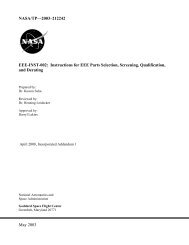

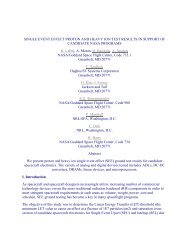
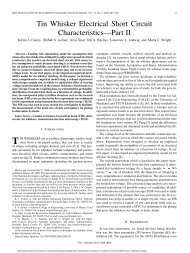
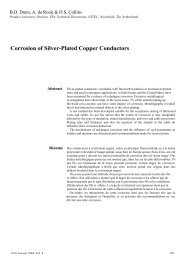
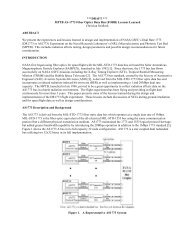

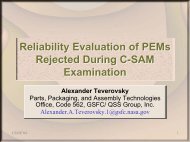
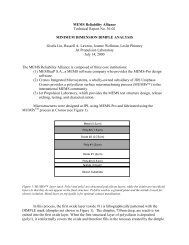
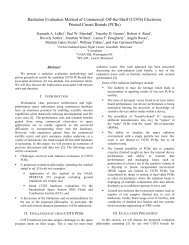
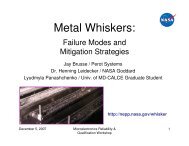
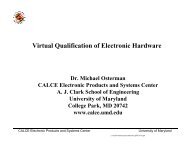
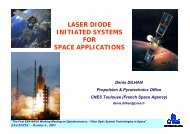
![mil-std-2223 [test methods for insulated electric wire] - NEPP](https://img.yumpu.com/4036001/1/190x249/mil-std-2223-test-methods-for-insulated-electric-wire-nepp.jpg?quality=85)